#bronze primary
Explore tagged Tumblr posts
Text

September 15, 2024:
Bronze Primary, Banescale, Edged.
Charizard of Konzen's clan!
17 notes
·
View notes
Text

#ancient breed#aether#male#hatchling#laced#bronze primary#rosette#indigo secondary#mandibles#lemon tertiary#nature#uncommon eyes
1 note
·
View note
Text
thought about a passage in like a Kalos History Book that's like... "While the king was mostly private in his relationships with women, it is thought by some that he may have had a favoured mistress during his rule. Though she is not mentioned by name, Caryscias of Medea writes that Though the king was often a lonely figure, there was a certain woman whom he often enjoyed the company of... I am not typically the type to conjecture, but I have reason to believe the relationship they shared was perhaps... 👀 less than appropriate 👄. However, because it is well known that Sir Caryscias was, in fact, quite fond of conjecture, this passage is typically regarded as mere fiction."
#🗨️ snowbelle city gossip#eternalflowershipping#kinda ???#i thought about nerine being referred to as a Mistress and started howling which led to this post#Caryscias is an OC I don't talk about a lot but#he's like one surviving primary source for what happened in bronze age kalos whose texts mostly survived#but he was a weird gossipy guy so there's a lot of ??? about the authenticity of his words
13 notes
·
View notes
Text
I kinda like how it came out, so here's a scry based off the San Francisco Garter Snake!


I felt kinda iffy leaving the primary ungened, but I wasn't really sure what could fit. I settled on pinstripe by the end, though


#I was gonna use tapir for the primary but then I remembered pinstripe#compared the two and preferred pinstripe#flight rising#flight rising scry#oh and colors are black/pistachio/bronze#and genes are pinstripe/spinner/contour#now that im thinking about it I really prefer how it looks with pinstripe over being basic
9 notes
·
View notes
Text
I want to knock the socks off all the presenters every year I come here for four years lol. I bet I can make the history of the hoist shaft absolutely fascinating.
#for 3 years i paint pictures of this huge Bronze age Trade network and the last year i sit everyone down#Today we're going to talk about hoist shafts#jk. have you ever thought about the cargo ships that are the primary buyers of your steel hoist shaft cable?#ptxt
2 notes
·
View notes
Text

Bogsneak Female
Bronze / Honey / Murk , Petals / Flair / Koi
Arcane Unusual
#flight rising#flight rising dragon#flight rising scry#scrying workshop#fr scries#flight rising bogsneak#fr bogsneak#bronze honey murk#petals primary#flair secondary#koi tertiary#arcane unusual#fr arcane#unusual eyes
2 notes
·
View notes
Text
I've been watching a lot of Omega Strikers guide videos lately and the one thing all of them have in common is that every single one of them highlights the importance of "just have fun".
That's something people say all the time, about any game. But there was one guide I watched yesterday, and in addition to giving that tip, also mentioned the importance of not being toxic and blaming your losses on your teammates.
This is genuinely the most helpful tip of all time. Like this guide really grilled into me just how horrible having that toxic mentality is. The full first minute of the video was dedicated to that. He also talked about how being toxic and playing w that mentality actively makes you worse at the game, period. Full stop. And he explained the reasoning for that as well.
I've heard this said and yeah I believe it as well, but this was the first time I'd ever had it thoroughly explained to me. It really put things into perspective for me.
Hoping I can improve at both Omega Strikers and Splatoon by keeping this in mind 👍
#The whole 'just have fun' + 'stop blaming others' is smth I've needed heavily reinforced for a while#I'm very bad at just having fun bc I want!!!!! To rank up!!!! So badly!!!!#And my Rasmus is horrible!!!!!#But. These guides have put a lot into perspective#It's so weird for me to actually follow anyone else's advice bc I've never had tk do that when I play splat yk?#Like I've been playing that game for years. I have a good grasp on it and I'm comfortable at the level I play (X rank/Egg vp)#I don't needa get crazy highwr than that#But Omega Strikers? Bro I'm stuck in FUCKING BRONZE 😭😭😭😭😭😭#I don't play too much tbh...but it's honestly cuz I'm super scared of ranking down#I also...don't practice...like if I'm playing I only play comp...#Why would I play without stakes...it's less fun to me that way...#But gahhhh maybe I should practice a little bit#Mostly need to work on fundamentals rn#Striking the core; dribbling; learning Rasmus' fucking hitbox + delay on his primary#Reaction time as well#I suck at striking the core bro 😭😭😭 But I will get better...#Mmmight do some practice later...but I wanna practice in quickplay...#Nah...I oughta play normal since it emulates the style of comp
8 notes
·
View notes
Text
Master Bath Bathroom Newark

Large transitional master bathroom with a built-in vanity, recessed-panel cabinets, white cabinets, green walls, an undermount sink, marble countertops, and white countertops with gray flooring and a double sink.
#oil-rubbed bronze shower doors#fan pattern tile#primary bath#accent#sliding shower doors#bathroom#skylight
0 notes
Text

Process shot of the asteroid truck stop Helix Paradox in my homebrew spelljammer game. I ran session three with the uncoloured version today but I really wanted to break out the markers I bought so I'm adding some much needed colour and depth.
Session three went great, we added a new player, so we're up to a five person band now, which is a good number for a group. I'm still calling it some Assembly required, while they figure out a name for themselves. Managed to get a bit of a battle in, they de-escalated a situation with a wraith, picked up some cargo for the ship, and are currently doing a job for a Hag who's hanging out in the garden.
Also the rp between them all is stunning. *Chef's kiss* I need to get better at writing things down during the game. I think I named four NPCs today and I don't know if I wrote any of the names down.
#dungeons and dragons#some assembly required#my art#fantasy map#worldbuilding#writing#i have four swatch pages somewhere else that i can't find which makes it obnoxious when I'm trying to test color choices#also whoever named the ohuhu chisel tip markers colours i am hoping its a major translation error#there are some terrible name choices here#deep sky blue is in the greens#im still trying to figure out what bronze purple is supposed to mean#primary yellow on the website looks blue#i get thats my screen but that should probably be adjust for is my guess
0 notes
Text

I have never seen a house in Topanga Canyon, CA that I didn't like, because they always have a mystical, magical feel, and this 1953 charmer is no exception. 3bds, 3ba, 2,562 sq ft and it includes a guest cottage. $2.35m.

Double gothic doors open to a lovely entrance hall/sun room. Look at the finials hanging from the corbels. That's different.

Enter a large room that's a flex space with two arched doorways to the living room.


It's an open concept floor plan that has the cutest little stone fireplace and a wall of windows that open to a deck.

There is plenty of space for a large dining table between the living room and kitchen.


The kitchen is spacious, yet so cozy with it's vintage stove, bronze double farm sink and cute cabinets. The counters are nice as well, and match the backsplash.

Did you see how the pretty flooring meshes nicely with the wood floor from the dining/living area?

Interesting powder room- look at the sink and walls- all sculpted by hand.

Very large primary bedroom has doors to the deck. This home is so sculptural- look at the niche and shelf right in the wall.


The bath has a double vintage sink and a cement or some sort of adobe tub.

This pass-thru hall is like a mini library with a stained glass window and skylights.

The secondary bedroom is large and sunny.

Bath with a cute vintage tub.


Beautiful deck with a fountain goes around the house and it has a great view of the canyon and mountains.

Up the stone stairs is the guest house.

There's a patio and covered deck out front.



Oh, this is so nice.

There's even a little sun room.
The ladder goes up to a sleep loft above the cute little kitchen.

Very nice shower room.

Lovely rock gardens. Look at the slide. Isn't that fun?


Topanga Canyon houses always make it feel like you're living in the trees.

Look at how the stones make hearts. So cute. .91 acre lot.
https://www.zillow.com/homedetails/2095-Topanga-Skyline-Dr-Topanga-CA-90290/20549321_zpid/

241 notes
·
View notes
Text
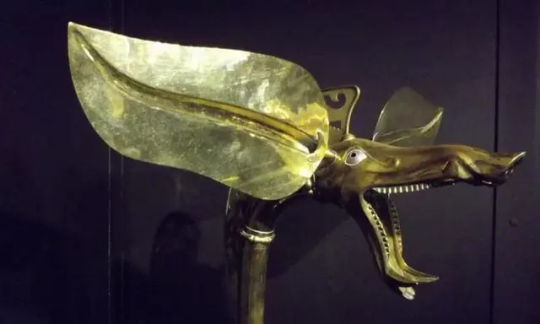

The 'Carnyx' Nightmare of the Roman Soldiers
The Carnyx was a brass musical instrument used as a psychological weapon of war by the ancient Celts between 300 BC and 200AD in western and central Europe and beyond.
The carnyx was once widespread throughout much of Europe, although only a dozen or so fragments are known to us.
It was carried by bands of Celtic mercenaries; it was present at the attack on the Greek sanctuary at Delphi in 279 BC; it defied Julius Caesar in Gaul; and it faced Claudius when he invaded Britain. They are even shown on a Buddhist sculpture in India, proof of the far-flung connections of the Iron Age world.
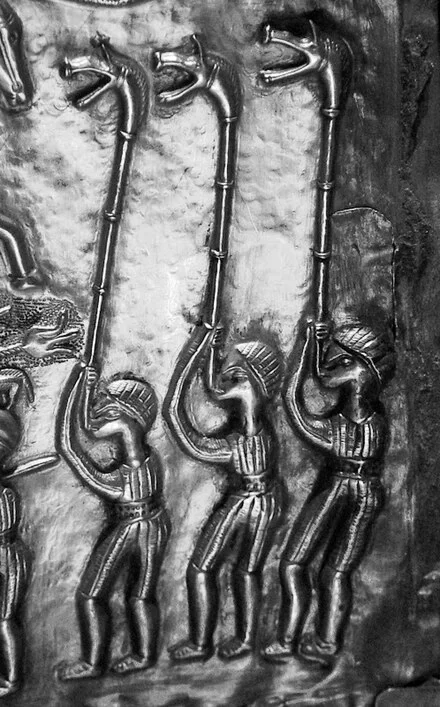
However, they were not only used by the Celts; they were also used by the Dacians in modern Romania. The term “Celtic” is a complicated one. The concept of a pan-European Celtic culture is a myth; rather, aspects of art and technology were shared across vast distances by diverse cultures. The carnyx was one example of this.
A 12-foot-long, thin bronze tube with right-angle bends on both ends made up the carnyx. The lower end ended in a mouthpiece, and the upper end flared out into a bell that was usually decorated to look like a wild boar’s had. Historians believe it had a tongue that flapped up and down, increasing the noise made by the instrument. The carnyx was played upright so that the boar’s head bell protruded well above the warriors’ heads. Its primary goal was to create more noise and confusion on the battlefield.
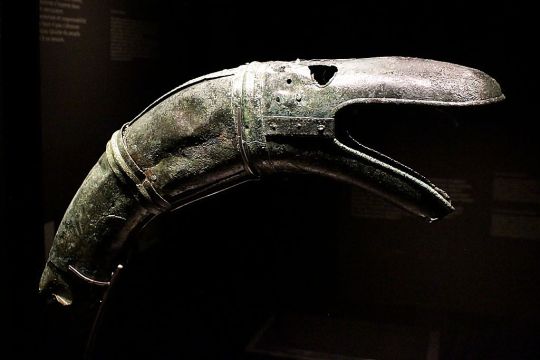
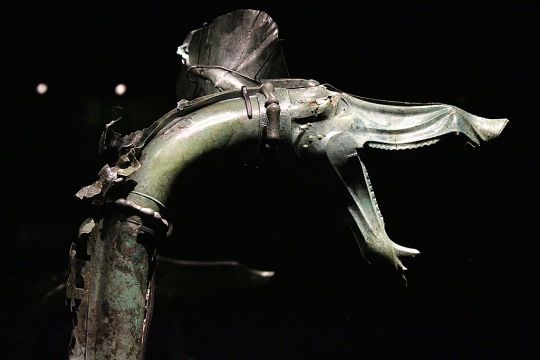

The Greek historian Polybius (206-126BC) was so impressed by the clamor of the Gallic army and the sound of the carnyx, he observed that “there were countless trumpeters and horn blowers and since the whole army was shouting its war cries at the same time there was such a confused sound that the noise seemed to come not only from the trumpeters and the soldiers but also from the countryside which was joining in the echo”.
And the Roman historian Diodorus Siculus wrote, “Their trumpets are also of a peculiar and barbaric kind which produce a harsh, reverberating sound suitable to the confusion of battle.”
Archaeologists discovered a hoard of ritually destroyed weapons in 2004, including a dozen swords, scabbards, spearheads, a shield, bronze helmets, an iron helmet shaped like a swan, a cauldron, animal remains, and seven carnyces. Before the Tintignac discovery, the remains of only five actual carnyces had been found.
The finest was unearthed in Deskford, Scotland in 1816. The Deskford carnyx only has the boar’s head bell and is missing the mane, tongue, and tubing. Images of Carnyx players have been found as well. A Roman denarius, dating from 48 BC bears a representation of a Carnyx. Three carnyx players are featured prominently on the Gundestrup Cauldron, which was found in a Danish peat bog.
One of the seven found at Tintignac, on the other hand, was almost entirely complete. The Tintignac Carnyx was broken into 40 pieces. When puzzled back together, it was found to be just an inch short of six feet long with a single missing section of the tube. The bell was a boar’s head with protruding tusks and large pointed ears. Once restored, the Tintignac Carnyx proved to be the first virtually complete carnyx ever found.
By Leman Altuntaş.
Music video by John Kenny.
#The Carnyx#The 'Carnyx' Nightmare of the Roman Soldiers#Iron Age war trumpet#ancient artifacts#archeology#archeolgst#history#history news#ancient culture#ancient civilizations#celtic mythology#celtic history#roman history#roman empire#roman legion
3K notes
·
View notes
Text

#coatl#male#hatchling#tide#bronze primary#patchwork#leaf secondary#soap#cantaloupe tertiary#earth#unusual eyes
0 notes
Text


Blanket #1 is finished and blanket #2 is probably halfway there
I don’t have anywhere to lay them out in full other than my floor and I will only be doing that to get final pictures when they’re all done
“How are you doing?”
Well I just spent $200 on yarn and am planning on making at least four full blankets before Christmas when I haven’t crocheted in 3 years sooooo…
#crochet#I made a mistake on blanket 2 but refused to frog back multiple rows to fix it so we made do#truly these pictures don’t do the neutral colors any justice#they’re so gorgeous in person#the greige has little bronze highlights throughout#I’m so happy I decided on it as the primary color
46 notes
·
View notes
Text
An overly complicated analysis of everything we know about Neve Gallus in canon, as well as some additional thoughts of mine on the themes surrounding her (because I am so gay for her already)
1. Canon information
- Her age is, as of yet, unknown. In the Tevinter Nights story The Streets of Minrathous, narrated in the first-person perspective by Neve, we read “He greeted me with a dismissive ‘young lady’ that made me think he’d forgotten my name” (216). However, this is a description by an older man, whose nephew is alive long enough that his “parents had disowned him years ago” (213). In another passage of the story, the following can be read: “The man was a con artist I’d turned in the year before. To be fair, he’d nearly gotten me killed the year before that, so we were even” (221). We can therefore be certain that she has engaged successfully in detective work for at least two years, and has likely been doing so for a while. We do not know when the story is set, neither do we know anything about the parallel stories of “The Wigmaker Job” and “Luck in the Gardens”. We get the information that a Venatori cultist was wearing clothes that are fading (220), and that the cult had long since lost much standing in society; it has likely been quite a number of years since 9:42. At the same time, we know of a Qunari invasion in the eastern part of the Tevinter Empire from 9:44/45 onward, with several major cities falling to the invaders. Neve describes the catacombs as “a place to hold a year’s worth of food and supplies, securing the city’s survival in case of blight or Qunari invasion” (232). A woman as observant and politically savvy as her would likely not frame an invasion as that much of a hypothetical in case of an ongoing war. It is reasonable to assume that the story takes place sometime around the middle of the forties. Which means that by the events of Veilguard, in the middle of the fifties, we should expect Neve to have had at least twelve years of experience as a private investigator, which places her likely age at minimum in the early thirties. (Not that I am hoping for anything 40 or upward, no, there is no MILF agenda here)
- She describes the manor of a rich man as “a residence nowhere near the third-rate bookseller where I rent a room” (216), locating her residence both outside of the rich parts of town, and informing us that she does not have the greatest of means.
- Likewise, we learn that her “family has more templars than mages. I’m sure that says a lot about me. The point is, I’m not from an old family and I felt as at home in Lady Varantus’s house as Jahvis looked” (218). Within the rigid social hierarchies of Tevinter, she is privileged by magehood, but not by blood. To the degree that Tevene social classes can be broken down so neatly into stratified categories, she seems to be somewhere in the lower ranks of the middle class.
- She is canonically disabled; an amputee wearing a prosthetic leg made of dwarven metal (215). In the comic The Missing #4, we see her prosthetic, it is designed as a cobra standing up in intimidation of an attacker, and the metal seems to be predominantly a bronze or gold with blue or silver accents (6). On her foot on the other leg, she is wearing a boot which has a bronze or gold tip symmetrical to the tail of the cobra, and a high plattformed heel (ibid). Combining that with the fact that she fights and runs with a prosthetic and a heeled boot (TSoM 215, TM4 16), we learn that she expresses immense control over her body.
- Likewise, she approaches all her actions, her appearance, and her communication verbal and physical with a high degree of precision and deliberation. Her outfit is perfectly composed, with white and dark leather as primary colours, the same blue-gold metal that her prosthetic is made out of for accents as well as her belt (which is a coiling snake, TM4 6), a dark turquiose for some of the cloth (such as pants and cravat), a light turquiose for such accents as her fingernails and her meticulously applied eyeliner, and some manner of cap akin to a graduation cap at the right side of her head, in an almost black brown, with gold details. The shape of the cap has the exact same angles as a rhombus as her earrings (TM4 9). The detail on the cap forms a snake. It has been posited by tumblr user @cleric4vampire that even her movement in the trailer reinforces the cobra/snake motive (https://www.tumblr.com/cleric4vampire/752850000700194816). Despite sometimes excrutiatingly long workdays (223), Neve puts an extreme amount of emphasis on her appearance. Even in the comic, while the style does feature very dynamic character movements while talking, her gestures stick out as particularly deliberate; she talks with her hands a lot, and with deliberation (see the appendix of this post for more). This speaks to a plethora of willpower, control, and a desire to maintain a controlled barrier between the self and the larger world.
- While writing this, I have come up with the theory that the blue accents of her apparell might partially be lyrium. If she is literally wearing lyrium makeup, I will marry her.
- The only two offensive types of magic that we see her use are ice magic (e.g. TSoM 226, 227, 235, TM4 16, 17), and a manner of magic that lets her freeze the moisture in the air around a person to stagger them (e.g. TSoM 214, TM4 17). Through cooling the air around herself a bit less, she manages to hide herself in mist (e.g. TSoM 214). She is capable of some healing magic (227).
- She has a network of contacts, acquaintances, and informants all over Minrathous, particularly in its underground.
- She loves salty fried fish (221). This is not only in line with Minrathous being a coastal capital, which has a distinct influence on the caloric inflow into the city and cuisine at large, but also, once again, stresses that she does not have much money at her disposal, by emphasizing that she eats fried fish from a cheap street food stall very regularly (221), which she calls her “fish dinners” (228).
- She canonically has straight dark brown hair, meticulously kept at the left side of her face to keep space for the cap on the right, brown eyes, and brown skin. It is furthermore canon that anyone who has a problem with that or wishes to change that with mods will be exploded via elemental magic. It is furthermore canon that I will not buy Veilguard if the game whitewashes her.
- She is involved with the Shadow Dragons in helping fugitive slaves (TM4 9, 20). She expressly approves of the use of armed violence against the institution of slavery. At one point, she comments: “The cult’s dead god wanted to bring Tevinter back to what it was—to its “glory.” It was nonsense, of course. It always was. The old empire was even more corrupt and heartless than what it is now, no matter how pretty the picture Corypheus painted” (TSoM 221). In her vocal resistance to the empire, she sees it as a good usage of her time to track down Venatori (214). In spite of her resistance against the empire, she considers the city her home and would like it to be better than it is (214, 221).
2. Themes: The noir detective and the empire
It goes without saying that the formational archetype behind the character of Neve Gallus is that of the noir detective. A solipsistic cynic with little means, a private investigator, called to investigate a crime scene in dance with and against the police, depending on the point of the story. The noir detective of the movies of the first half of the 20th century, the formational corpus from which stems the archetype, is distinctly tied to the metropolis; a story that needs the urban context, the urban scenery. While of course featuring a plentitude of settings and configurations, at the root of the archetype rest particularly a white, male, US-American figure. To bring Minrathous in parallel with New York particularly is in so far a welcome change as it means a partial departure from the orientalism underlying a lot of early descriptions of Tevinter in Dragon Age canon. But, to me at least, it raises the question of how well Dragon Age is equipped to tackle the arising thematic implications. Just like the Tevinter Empire, the United States of America is a slave society fueled by the deprivation of Indigenous communities and the physical exploitation of a racialized, disenfanchised class. The metropolis is the core of the imperial core; and Minrathous is, as the largest city of Thedas and the capital of Tevinter, certainly that. The Streets of Minrathous manages but a partial critique of the society of the imperial-colonial metropolis. While Neve remains critical of the templars, the undeniable cop stand-in, the critique remains bound to corruption the higher one goes in the chain of command, as well as the bureaucracy (231). The story, in particular, follows the very dangerous trope commonly found in copaganda that the base-level officers should be allowed to disobey the chain of command and act on their own, particularly when it comes to the deployment of heavy weaponry (234). That the base-level officer is as much an agent of imperial violence as the top of the hierarchy, turning the systemic and depersonal violence of the system into concrete interpersonal violence, cannot be formulated by the text.
Furthermore, the Venatori, in their supremacist-fascistic death cult, remain cast in ableistic terms that deprive their ideology of systemic connectedness: “that didn’t stop remaining loyalists from acting delusional and stirring up trouble when the mood struck. That’s fanatics for you” (213). That fascism is but the logical conclusion of empire, particularly a weakened and collapsing empire, remains just as unacknowledged. And yet, what haunts the story is a profound sense of loneliness and alienation. A rich man estranged and alienated from his nephew because of his fear of social repercussions for the nephews behavior, said nephew dying while grasping to any semblance of connection he can (“He knew what came next. He was searching for whatever company he had left” 215), Neve facing the cultists in their hideout alone because the templar Rana does not want to breach protocoll, hell, even the Venatori preacher making a ridiculous figure, alone and ignored on his soapbox while the masses rush by him and shut him out of their attention; everyone is lonely, seperated by the dividing and isolating forces of the empire. The imperial metropolis condenses people, yet they are emotionally distanced from one another. Neve’s final action in the story is to return to the rich old man, explaining to him that his nephew was trying to be good after all; a post-mortem attempt to mend but one severed connection between humans. Her entire character is defined by the trajectory that comes from wandering almost aimlessly in a desperate attempt to escape the solipsistic nature of the empire. Her defining emotional conflict is with the reality of empire, as much as her status as a brown, disabled, bisexual woman clashes with the roots of the figure of the noir detective. We see by the time of The Missing #4 that she finds a sense of fulfillment in working with the Shadow Dragons for the slaves and against the slavers, which hints at a character arc from TSoM to TM4. As Varric correctly observes, she has a heart of gold (TM4 20), one which she hides behind a particularly controlled facade, as stern as beautiful. How well her character plays out in Veilguard hinges entirely on the stories limited ability to discuss empire in meaningful terms, and the story’s willingness to further explore her emotional arc suggested between TSoM and TM4. I am furthermore worried about how well a series known for its overt centrism can handle the nuances that make her character so great, as well as fearing the reaction by gamers[TM] to having a brown, female, disabled, bisexual detective.
3. Appendix: I am gay for the way she talks with her hands and body

TM4 9

TM4 9

TM4 5

TM4 10

TM4 14
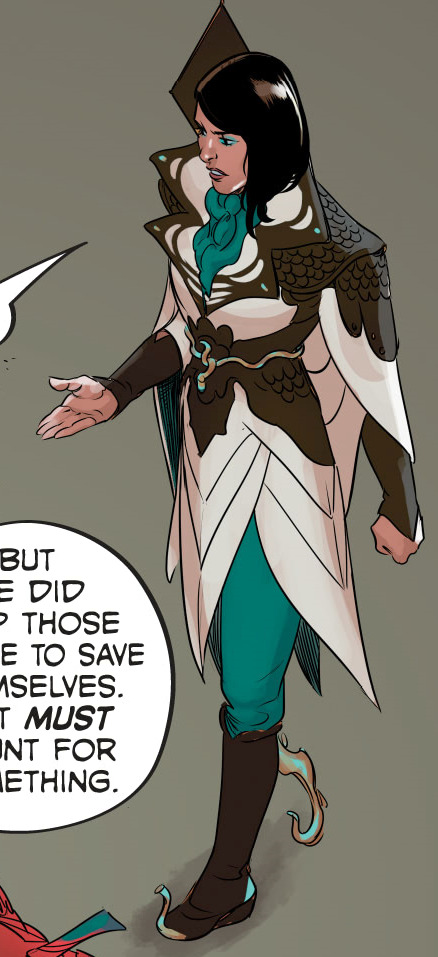
TM4 19
207 notes
·
View notes
Photo
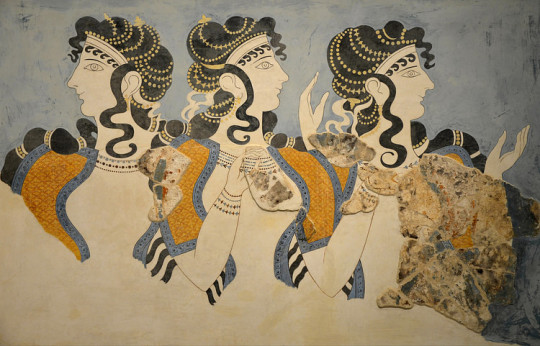
Beauty in the Bronze Age - Minoan & Mycenaean Fashion
Dress and appearance in Bronze Age Greece (c. 3100 BCE - c. 1100 BCE) played a part in defining gender roles and emphasising idealized beauty that planted the seed for modern-day standards. The Minoans turned the island of Crete into a Mediterranean powerhouse and dominated Aegean culture until around 1450 BCE when the Mycenaean civilization from the Greek mainland peaked and wrested control. Frescoes and figurines uncovered from this era reveal a fabulously colourful society that expressed itself through fashion, hair, and accessories. Both Minoan and Mycenaean women sought a pinched waist to achieve the epitome of a feminine aesthetic. The fashion of Mycenaean men, however, expressed their warlike temperament, in contrast to their Minoan counterparts, who embodied display and splendour.
Minoan Women
Women are heavily represented amongst the archaeological finds from Knossos, Akrotiri, and other Minoan hubs. One of the most beautiful examples is the Snake Goddess Figurine which depicts the archetype of Minoan dress. This woman wears a flounced, layered skirt that falls to the ground. Her bodice has short sleeves and a scalloped neckline which reveals and accentuates her breasts. This is mirrored in the colourful frescoes which emphasise bright, eye-catching fabrics dyed a myriad of colours. Bold primary colours – reds, yellows, and blues − dominate the pattern scheme. To get these shades, the Minoans took advantage of the available natural resources. Saffron – now the world’s most expensive spice – was used to acquire yellow and murex sea snails created a rich purple.
One of the most interesting aspects of female dress was the use of corsets or tight thick belts to create an hour-glass figure. Artworks suggest that the wasp-waist was highly idealised in Minoan culture and body modification may have been implemented to achieve this. Corsets have, of course, gone in and out of fashion in the thousands of years since their early Cretan use. Minoan women also wore jewellery to frame their features. Hoop earrings, necklaces, and bangles were all popular forms of expression and decoration − gold and glass beads were used to give outfits that glamourous touch.
In the frescoes, women have black hair braided into long tendrils or locks. Their skin, in contrast, is typically a pale white, implying that the ideal women would have spent significant time indoors and that the archetype of feminine beauty could be obtained by focusing on domestic duties.
Continue reading...
130 notes
·
View notes
Text

Veilspun Female
Oilslick / Sunset / Bronze , Laced / Constellation / Flecks
#flight rising#flight rising dragon#flight rising veilspun#fr veilspun#scrying workshop#flight rising scry#fr scries#oilslick sunset bronze#laced primary#constellation secondary#flecks tertiary
12 notes
·
View notes